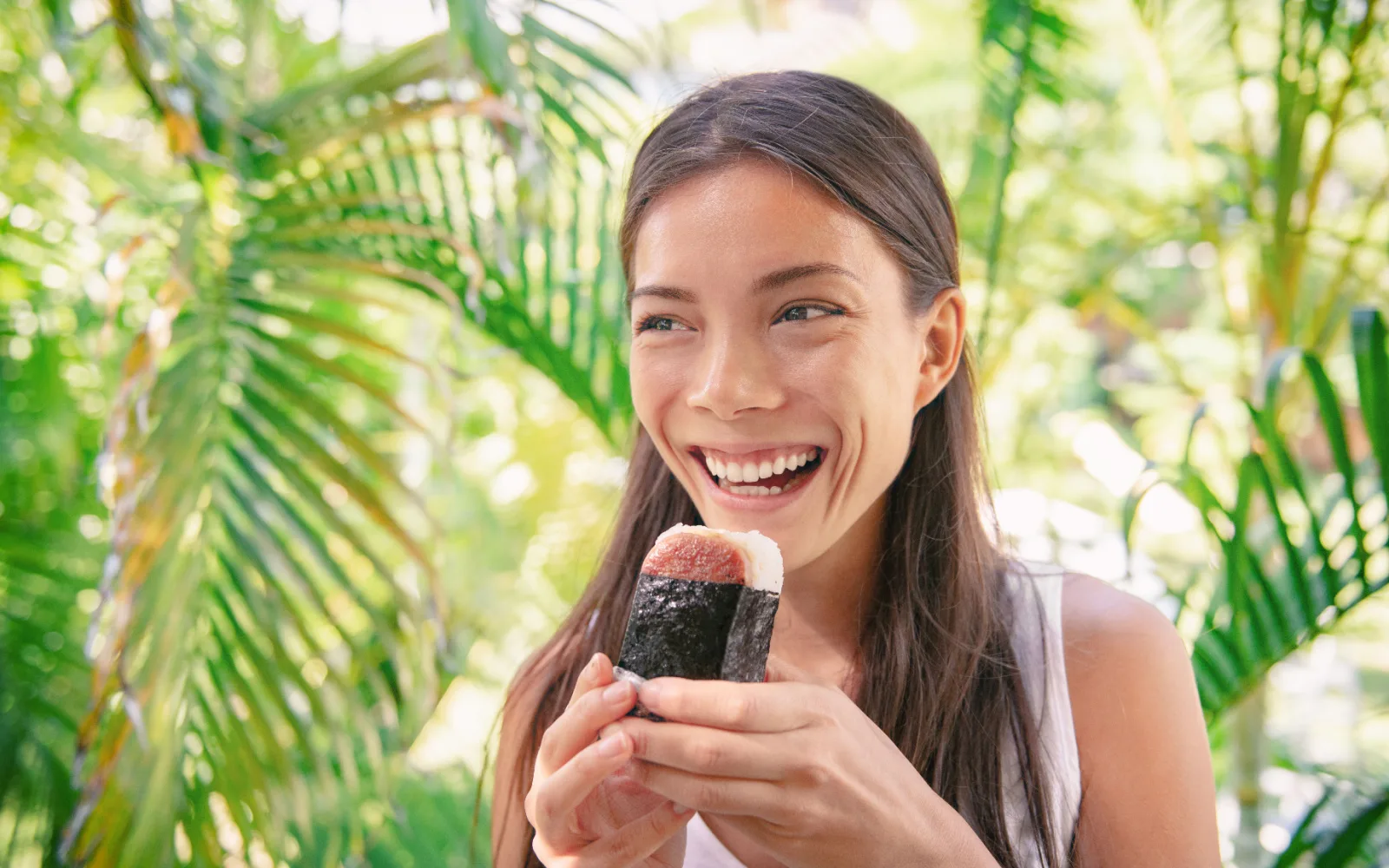It seems like every restaurant and food truck serving up grub in Hawaii offers at least one SPAM dish — and nobody’s mad about it. So why is SPAM so popular in Hawaii?
If you’ve been confused about the hold this canned meat product has on the people of America’s most tropical state, we’re about to clear things up.
When you’re finished reading, you’ll have a full understanding of why SPAM is such a staple food in Hawaii, how long the obsession has been growing, and some of the most popular dishes locals love to make with this love-it-or-hate-it lunch meat.
Why Is Spam So Popular in Hawaii?
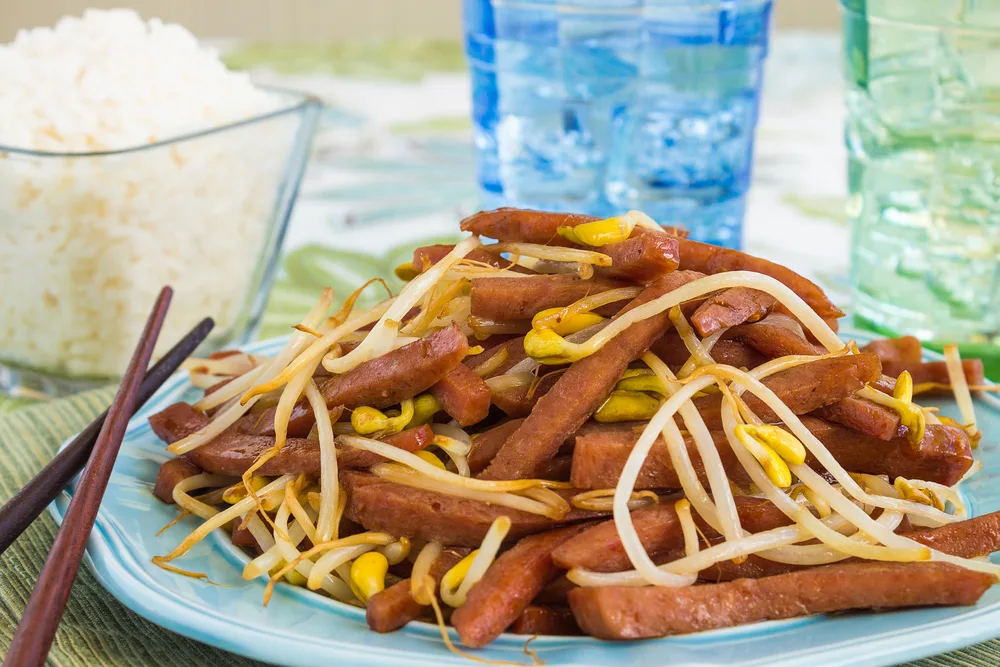
Leigh Anne Meeks/Shutterstock
SPAM (the trademarked name is spelled in ALL CAPS as per Hormel’s request) has been a staple food in Hawaii since the 1940s.
That’s right — SPAM was a big deal here even before Hawaii became a state in 1959.
Back then, World War II soldiers needed plenty of shelf-stable, filling protein and SPAM reliably delivered.
It was cheap, didn’t spoil in the heat, could be eaten straight from the can, and didn’t need refrigeration. In short, it was the perfect soldier food.
The military recognized this and purchased over 150 million pounds to feed the troops in the Pacific theater. And feed they did.
The pervasive nature of SPAM in GI meals on the Hawaiian islands in those days led to an endearing nickname “Special Army Meat.”
It wasn’t just Hawaii that got introduced to SPAM during the war.
Soldiers in Guam, Okinawa, the Philippines, and other Pacific islands became well-acquainted with the meaty goodness that is SPAM during the 40s.
The product wound up on grocery store shelves throughout the islands soon after, leading to Hawaiian locals’ eventual embracement and appreciation of this unique canned meat.
People in Hawaii really took to the convenience, flavor, and versatility of SPAM. But they didn’t eat it the way soldiers did.
Instead, they got creative and put local flavors, ingredients, and special cooking techniques into use to create SPAM-based dishes with true Hawaiian flair.
SPAM in Hawaiian cuisine has become so ubiquitous that it’s in tons of pop culture references, printed and referenced on clothing, and inspired an annual SPAM festival on the islands.
The arrival of SPAM on Hawaii’s shores during World War II may be the reason that the islands got their first taste of the canned stuff, but why is SPAM so popular in Hawaii?
Plenty of people have tried SPAM and vowed to never again eat it. Some just don’t appreciate the texture, flavor, or appearance. So what makes Hawaiians go crazy for it?
We’ll take a look at that next by reviewing a quick history of SPAM, different dishes that Hawaiians love to make with SPAM, and some of the flavor varieties that inspire delightfully different dishes.
What Is Spam?
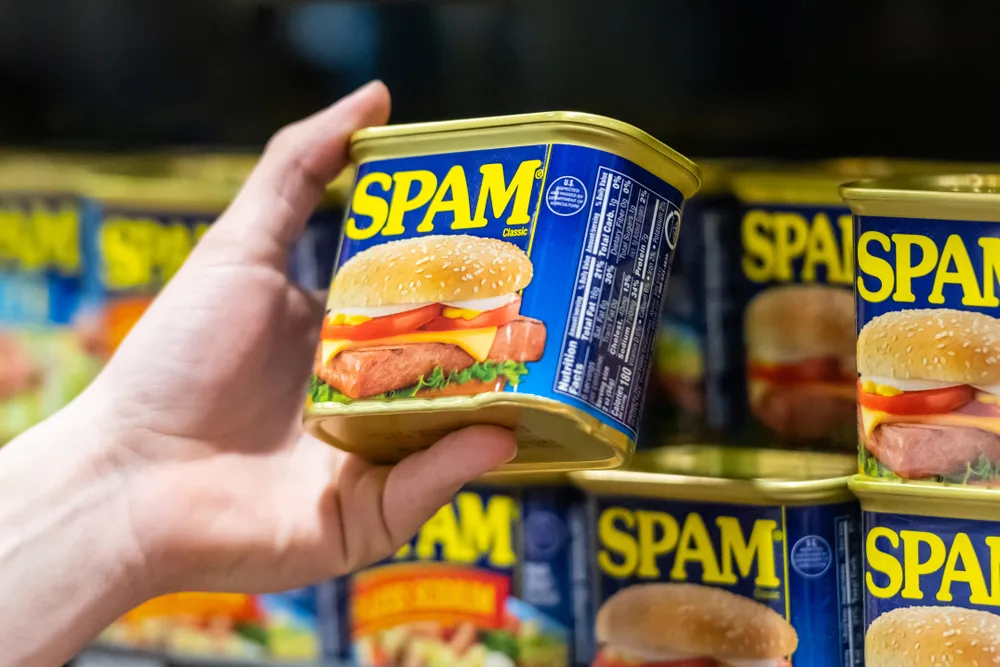
Customer hand holding a tin can of Classic SPAM in a supermarket aisle in L.A., Apr. ’19/calimedia/Shutterstock
The history of SPAM begins in 1937 when Minnesota’s Hormel Foods created a canned meat product made with ground pork shoulder, ham, salt, sugar, water, sodium nitrite, and potato starch.
Hormel found that by grinding the meat and combining it with other ingredients before vacuum-sealing and cooking the mixture directly in the cans, they had created a new, shelf-stable meat product that could be eaten without heating or refrigerating.
The only problem? It didn’t have a name.
When the brother of one of the big wigs at Hormel, New York-based actor Ken Daigneau, combined the words “spiced” and “ham,” the official name SPAM was born.
The product was tasty, cheap, and easy to prepare in a variety of dishes. It was originally marketed as a lunch meat (as the image on the can demonstrates) that could be eaten on a sandwich with condiments and veggies.
The Great Depression widened the appeal of SPAM, giving families across America an inexpensive protein option to serve at lunch and dinner.
But it wasn’t until World War II, when SPAM was distributed widely to soldiers, that SPAM really became the legend and essential part of the American lexicon that it is today.
By 1959 (coincidentally, the same year that Hawaii became a state), Hormel Foods reached an incredible milestone after selling their one-billionth can of SPAM.
And while we’d like to say that the rest is history, the truth is that once Hawaii got hold of this product, they managed to add an entirely new chapter to SPAM’s history, uses, and significance.
How Hawaii Became Obsessed With Spam
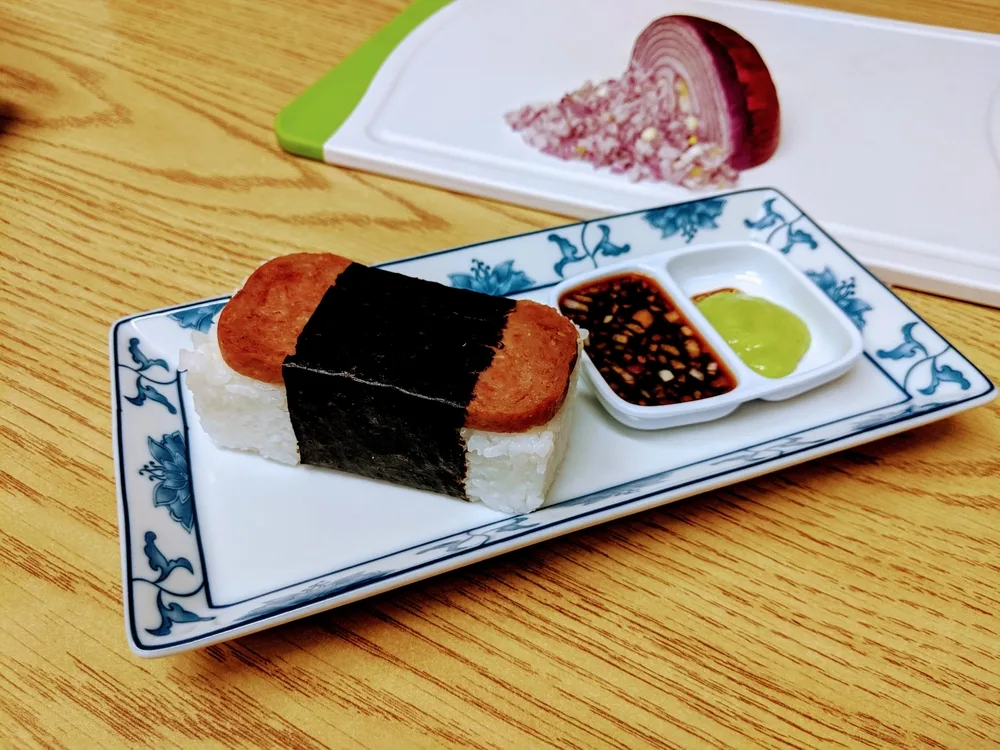
Ronald.Rogers789/Shutterstock
It’s not an exaggeration or an overplayed cliche — Hawaiians really, really love SPAM. It’s on every menu — McDonald’s and Burger King included. It’s even offered at upscale restaurants.
SPAM is a foundational part of Hawaiian family meals for breakfast, lunch, or dinner. It’s the basis for the annual springtime SPAM Jam festival in Honolulu, Oahu.
But SPAM is notorious for being a food that people either love or hate. So why do so many Hawaiians fall into the “love” category?
It might have something to do with the nature of Hawaiian culture itself.
As a group of remote islands in the Pacific Ocean, Hawaii has historically borrowed and combined elements from other cultures and immigrants to create a flavorful stew of cultural diversity.
From Filipino and Japanese to Spanish and American, many different flavors, languages, and traditions have found their way to Hawaii’s shores.
One of the major elements of Hawaiian culture is the preparation and sharing of food.
This part hails from Japan, where the concept of omiyage permeates the culture and involves bringing people gifts and souvenirs from your travels.
Omiyage means you’ve been thinking about the person or people you bring gifts for while you’re traveling and it’s a sign of respect and caring. When you get back, you share the gifts — which often include food.
As Hawaiians adopted this cultural tradition, food items were exchanged and shared as part of travels near and far as well as at general gatherings.
A lot of Hawaii’s food is imported, even today, and the necessity to bring in outside resources further opened Hawaiian people up to flavors and items from other cuisines.
The concept of bringing people a new food to try is one that Hawaiians are deeply familiar with, so it makes sense that when Americans brought SPAM to the islands, they saw it as a shared item to bring into local dishes.
Hawaiians didn’t just eat SPAM out of the can and call it a day. They expertly sautéed it, combined it with local flavors and spices, added staples like rice and eggs, and experimented with new ways to serve it.
Most Popular Spam Recipes in Hawaii
Hawaiians are eating a lot of SPAM, but what are the most popular ways to prepare and eat it?
SPAM Loco Moco, SPAM musubi, SPAM fried rice, and Saimin with SPAM are some of the favorites. Here’s what those dishes contain.
1. Spam Loco Moco
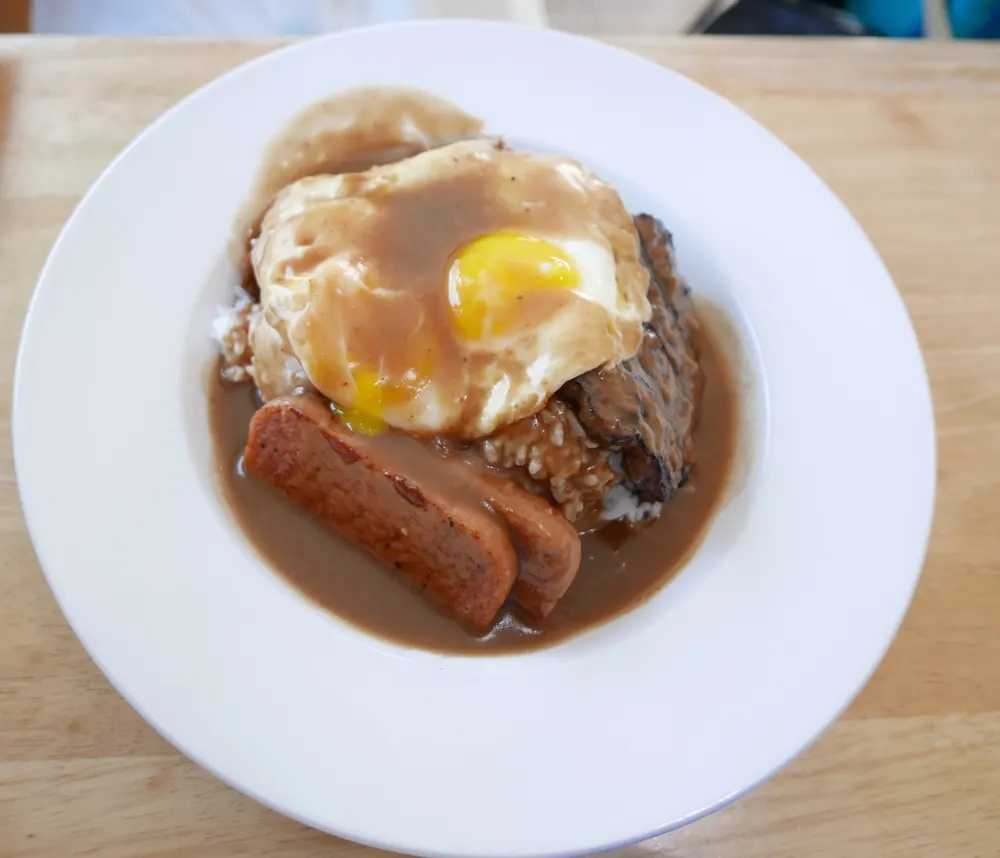
HappySari/Shutterstock
Eggs, fluffy rice, brown gravy, and sautéed SPAM are the main ingredients in SPAM Loco Moco, a twist on a Hawaiian favorite usually served for breakfast.
SPAM pieces are quickly fried in a pan and served over a bed of white rice topped with eggs over easy. The entire dish gets ladled with rich, brown gravy for a satisfying meal that’s packed with flavor.
2. Spam Musubi
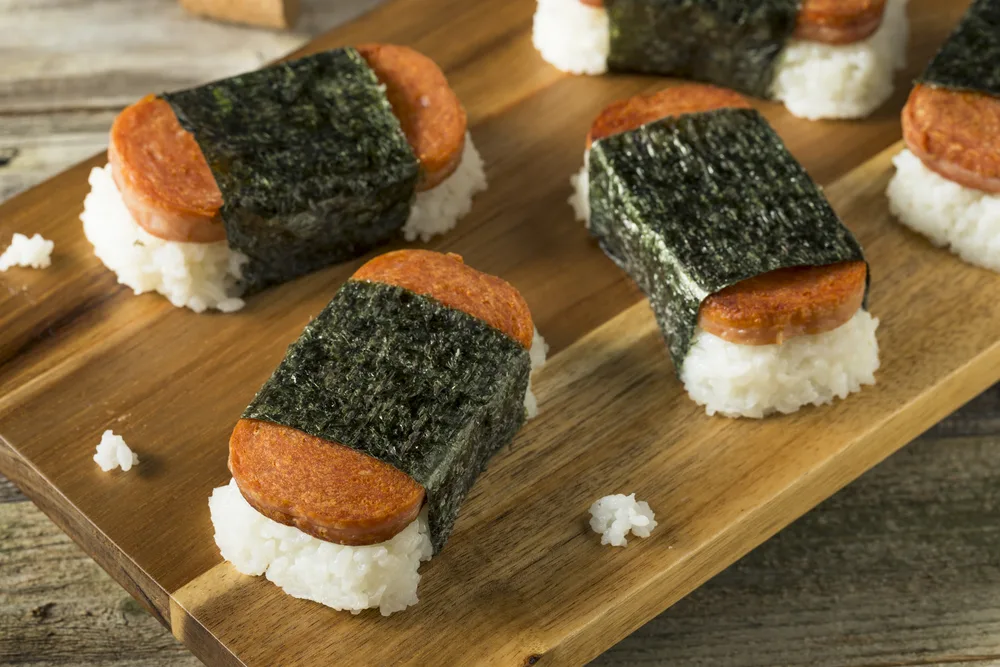
Brent Hofacker/Shutterstock
Musubi, or onigiri, is a traditional Japanese rice ball formed and wrapped in nori (seaweed). SPAM musubi, then, is a fusion dish that marries the rice ball with the salty flavor of sliced and grilled SPAM.
A block of sticky rice gets topped with a slice of grilled SPAM, then the entire thing is wrapped in sheets of nori to form a compact and portable “sandwich” that you eat with your hands.
3. Spam Fried Rice

vm2002/Shutterstock
This Asian-inspired dish combines cooked rice, diced SPAM, scrambled eggs, garlic, soy sauce, and sesame oil to create a tasty fried rice that’s packed with protein.
Diced SPAM cooks up in rice quickly fried in oil. Eggs, garlic, soy sauce (or the umami-bomb of Maggi Seasoning), and a drizzle of sesame oil complete the dish.
4. Saimin With Spam
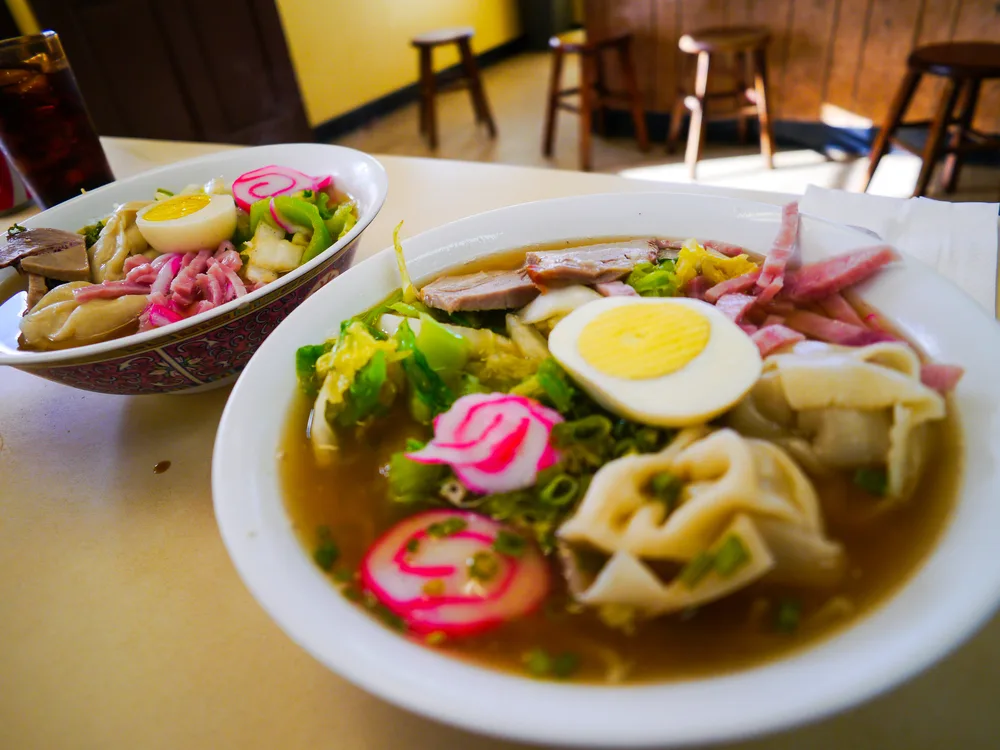
HappySari/Shutterstock
Saimin — similar to ramen — is Hawaii’s national dish, and with SPAM added, it’s even better. These skinny noodles are served up in a salty broth with onions, SPAM, and fish cakes.
You might find more ingredients in some versions of saimin with SPAM, including other proteins and special spice mixtures. It’s served in a bowl as a delicious, filling soup.
Things to Consider
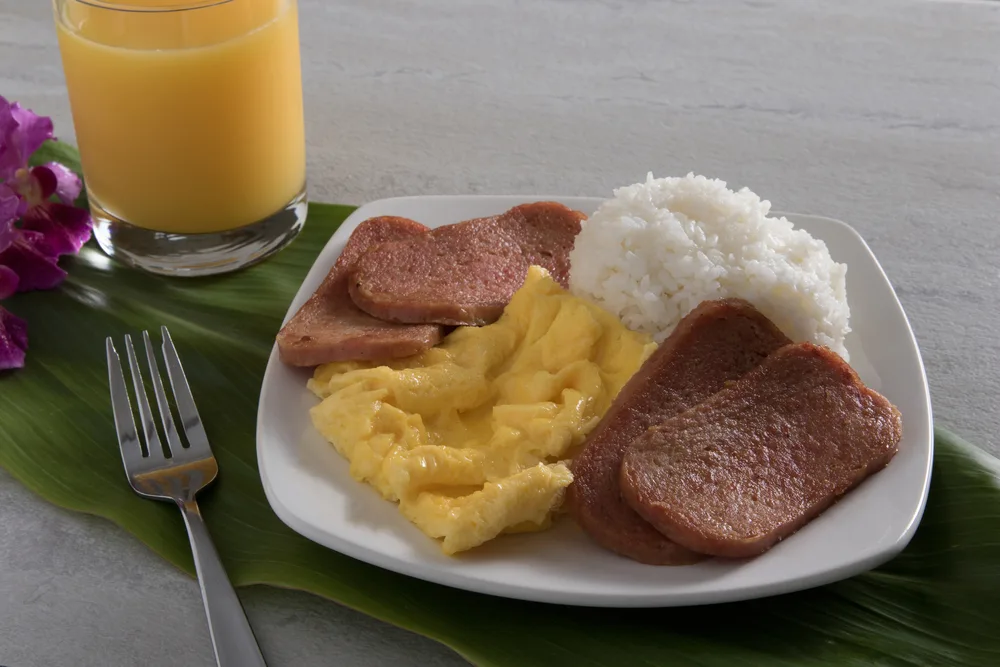
stuart_m/Shutterstock
We’ve looked at the history of SPAM and why it’s oh-so popular in Hawaii. Here are some other interesting things to know about this canned meat product!
- SPAM tastes like salty ham. If you’ve never actually tried SPAM, the taste is similar to a saltier ham. There are other flavors available which offer slightly or wildly different flavors if you’re not a fan of the hammy taste of regular SPAM. Once you’ve tasted it, you’ll see why it’s included in many dishes that might traditionally use ham or pork.
- It’s a wildly popular food. Today, Hormel says 13 cans of SPAM are eaten every second of every day. We have to wonder how many of those cans are consumed in Hawaii!
- It’s local, not Hawaiian. Locals are careful to differentiate the dishes containing SPAM as “local food,” not “Hawaiian food.” If you’re planning on visiting and want to try one or all of these dishes, make sure you reference them the right way.
- Slice it thin and fry it up. Not sure how you feel about SPAM? Locals swear by slicing it thinly and frying it up in a pan to get some color. It can bring out the savory flavors and make both the appearance and taste a lot more appetizing!
- It’s still cheap today. While grocery prices are going up, a can of SPAM costs around $2-$3 for a 12 ounce can. You can even buy it in multi-packs containing 2 to 8 cans if you want to stock up!
Frequently Asked Questions
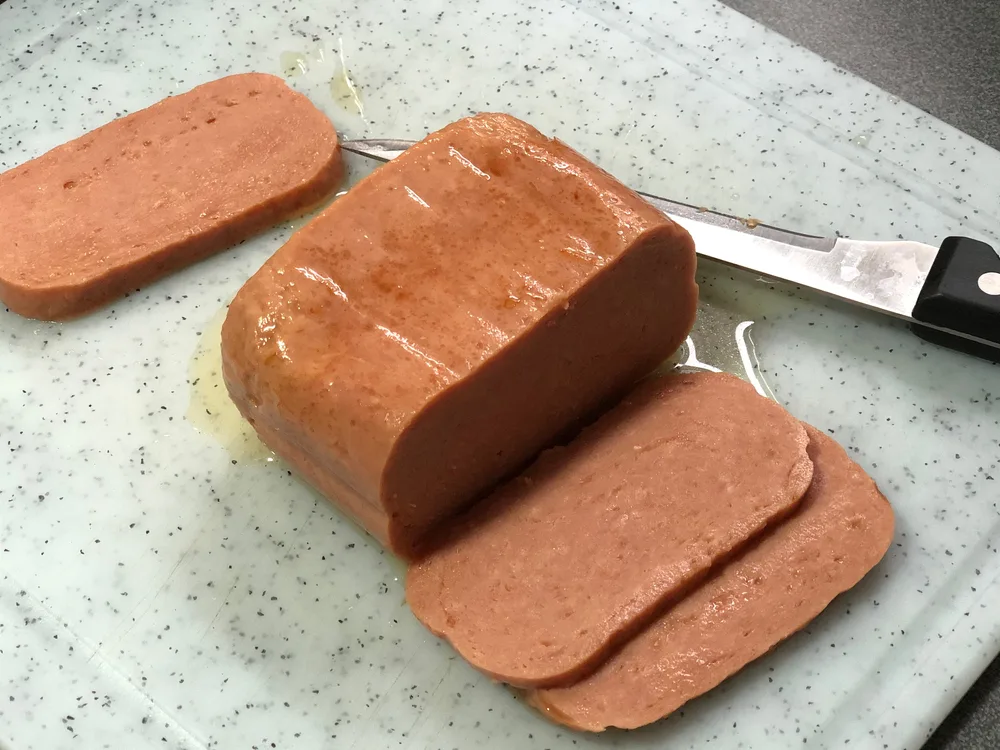
Niko Natsuki/Shutterstock
If you wondered why is SPAM so popular in Hawaii, the chances are good that you’ve also asked yourself some of the following questions.
Read on to learn more about Hawaii’s love affair with this meaty marvel!
Do Hawaiians eat a lot of SPAM?
Hawaiians eat a lot of SPAM, to the tune of 7 million cans annually. That’s according to Hormel, the makers of SPAM.
It’s more SPAM than any other state in the US, so it’s safe to say that Hawaiians love their SPAM!
What do Hawaiians call SPAM?
Hawaiians usually call SPAM by its name, but some will refer to it as the Hawaiian steak as a tongue-in-cheek reference to how revered-yet-affordable this product is in the state.
Did Hawaii invent SPAM?
Hawaii did not invent SPAM. It was created in Minnesota at Hormel Foods, where it was eventually distributed to American soldiers during World War II as an affordable, shelf-stable protein.
The product was a hit with locals and even after the war, Hawaiians continued to buy and use SPAM for many different dishes, giving it their own local spin.
Why is SPAM under lock and key in Hawaii?
As food costs rise across the world, theft is also increasing. Popular products like SPAM are now under lock and key at some Hawaiian grocers to prevent shoplifters from making off with the goods.
Do they serve SPAM at McDonald's in Hawaii?
You can order a SPAM breakfast platter at many McDonald’s locations in Hawaii, but it's not available elsewhere in the US.
Since McDonald’s often offers special dishes that are catered to specific markets, they recognized that Hawaiians love SPAM and incorporated it into the menu there.
So, Why Is Spam So Popular in Hawaii?
We’ve looked at the history of the product, how it made its way to Hawaii, and some of the most popular dishes containing SPAM. Let’s recap — why is SPAM so popular in Hawaii?
It’s been a staple protein source in the islands since World War II, it’s affordable, and it tastes great in many of the dishes Hawaiians are already eating for breakfast, lunch, or dinner.
SPAM is shelf-stable and easy to get, can be stretched for a family in dishes where it’s diced (like SPAM fried rice), and is available in a variety of flavors.
What’s not to love, really? SPAM is popular in Hawaii because it’s yummy, filling, and accessible.
And is it a coincidence that Hawaii has the longest life expectancy in the US (80.7 years) and is also the #1 consumer of SPAM? We may never know.


